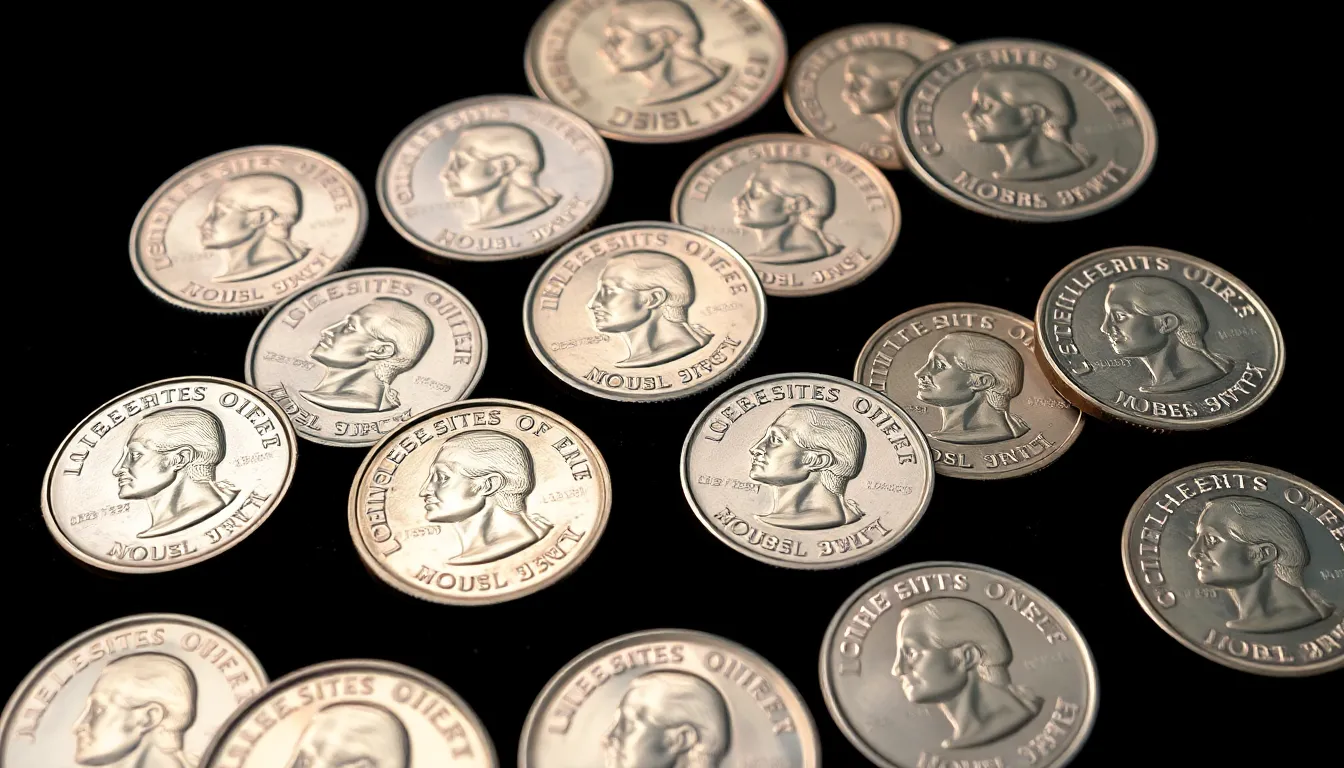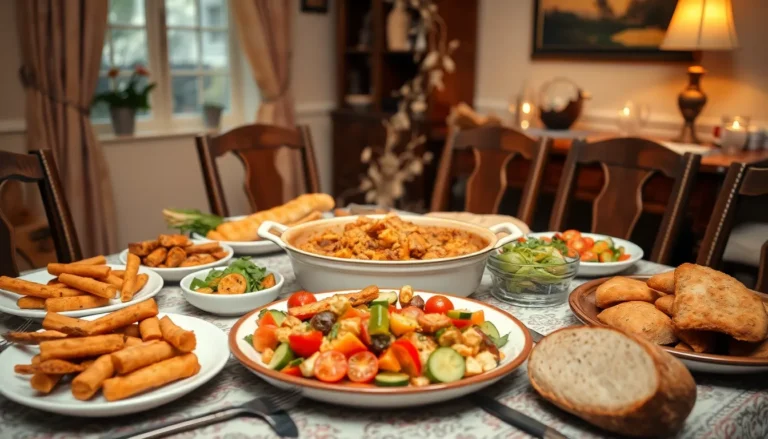In a world where pocket change often gets tossed aside, some modern quarters are hiding a secret: they’re worth more than their face value. That’s right! While most folks are busy counting pennies, a savvy few are cashing in on quarters that could make them richer than a kid in a candy store. Who knew that shiny coins could pack such a punch in the value department?
Table of Contents
ToggleUnderstanding Modern Quarters
Modern quarters can hold significant value beyond their face value of 25 cents. Several factors contribute to their worth, including rarity, collector demand, and unique minting errors. Minting locations, such as Denver and Philadelphia, play a crucial role in determining a quarter’s desirability.
Specific editions, like the 1999 Vermont state quarter and the 2004 Wisconsin state quarter, attract collectors due to limited releases. The 2019-W quarters, minted at the West Point Mint, released in small quantities, also pique interest among numismatists.
Varieties created from errors or misprints might elevate a quarter’s value dramatically. Quarters with double die or those featuring an incorrect mint mark can fetch hundreds or even thousands of dollars at auction.
Condition impacts worth significantly—well-preserved coins in uncirculated condition command higher prices. Assessing a quarter’s grade involves examining factors such as luster, scratches, and wear.
Collectors often utilize resources like the Professional Coin Grading Service (PCGS) or the Numismatic Guaranty Corporation (NGC) for accurate valuations. Traditional pricing guides and online auction sites provide insight into current market values, helping collectors determine the potential worth of their quarters.
Modern quarters offer a fascinating intersection of history and finance. As more collectors become aware of these valuable coins, the market continues to evolve, revealing treasures previously overlooked by the average individual.
Key Factors That Determine Value

Modern quarters can significantly vary in value based on several key factors. Understanding these factors helps collectors and enthusiasts identify valuable coins in their collections.
Minting Errors
Minting errors often lead to increased value for specific quarters. Variations such as double dies, incorrect mint marks, and off-center strikes capture collectors’ interest. A quarter with a noticeable minting error can sell for hundreds or even thousands of dollars. Auction results frequently show that collectors prioritize these unique coins over standard releases. Spotting these errors usually requires careful inspection; however, many collectors find it rewarding.
Rarity and Demand
Rarity directly correlates with a quarter’s market value. Limited edition quarters, such as the 1999 Vermont state quarter, attract more buyers and often command higher prices. Demand stems from collectors who seek specific years, mint marks, or designs to complete their collections. Popularity continues to rise for quarters minted in small quantities, like the 2019-W series. Trends fluctuate, yet certain quarters consistently remain highly sought after by numismatists. Collectors need to stay informed to take advantage of these opportunities in the market.
Notable Modern Quarters Worth Money
Certain modern quarters hold significant value beyond their face value due to rarity, collector interest, and unique errors.
1999 Delaware Quarter
The 1999 Delaware quarter features a unique design and has become a focal point for many collectors. This quarter became valuable due to its lower mintage compared to other state quarters. Well-preserved examples can fetch prices exceeding $10, while uncirculated specimens may reach hundreds of dollars. The rarity is attractive to collectors, prompting active trading and bidding, particularly at auctions. Mint errors involving this quarter, such as double dies, further enhance its value. Due to these factors, the 1999 Delaware quarter remains in high demand among numismatists.
2004 Wisconsin Quarter
The 2004 Wisconsin quarter gained attention because of its distinctive design and specific minting errors. Certain variations feature an extra leaf on the corn stalk, which makes these coins especially sought after. These rare specimens often command prices above $20, while uncirculated versions can sell for significantly more. Collectors appreciate the unique minting process resulting in these errors, which adds to its allure. This quarter attracts enthusiasts eager to complete their collections, resulting in competitive bidding during auctions. Its desirability continues to grow, solidifying the 2004 Wisconsin quarter as a notable piece in modern coinage.
How to Evaluate Your Quarters
Evaluating quarters requires a systematic approach. Start by inspecting the coin’s condition. Coins in uncirculated condition display no wear and have a pristine appearance, significantly increasing their value. Examine the mint mark located on the reverse side of the coin, identifying its origin, whether from Denver or Philadelphia, as this impacts desirability.
Look for notable minting errors, which can dramatically enhance a quarter’s worth. Errors like double dies or incorrect mint marks attract collectors and can lead to sales in the hundreds or thousands. Familiarize yourself with identifying features of sought-after quarters, such as the 1999 Vermont or 2004 Wisconsin state quarters. These quarters often possess traits making them especially valuable.
Consult reputable grading services like the Professional Coin Grading Service (PCGS) or the Numismatic Guaranty Corporation (NGC) for accurate evaluations. Understanding grading scales helps in assessing value based on factors like wear, scratch marks, and overall appeal. Study pricing guides and browse online auction sites for current market trends. Collectors frequently list coins based on their value, giving a clearer picture of the quarter’s market potential.
Additionally, conduct a comparison to similar coins. Observing sales of like-coins reveals the current demand and can guide expectations on pricing. Remember that rarity plays a critical role; quarters with lower mintage generally command higher prices. Tracking these elements ensures a comprehensive evaluation. Each of these factors contributes to a quarter’s unique market value, offering insights into potential profitability for collectors.
Best Places to Sell Modern Quarters
Selling modern quarters involves various avenues, each catering to different needs and potential profits. Online auction sites, like eBay, provide a broad audience, allowing sellers to reach collectors eager for specific coins. Local coin shops often purchase quarters directly, offering immediate cash and expert evaluations. Coin shows also present an opportunity to sell, allowing direct interactions with collectors and dealers, often resulting in profitable transactions.
Social media platforms have emerged as valuable marketplaces as well, enabling sellers to connect with niche groups dedicated to coin collecting. Websites like Facebook and specialized coin forums feature groups focused on buying and selling coins, increasing visibility. Additionally, classified ads in community newspapers can attract local buyers, providing a more personal selling experience.
Selling quarters through auction houses can maximize value for high-end or rare coins. These professionals handle the listing, marketing, and auctioning process, often yielding competitive bids from serious collectors. He or she could also consider peer-to-peer selling platforms like Craigslist or OfferUp, ensuring they meet potential buyers face-to-face for safety.
Strict adherence to proper evaluation and grading ensures a successful sale. Accurate descriptions and quality photographs enhance the appeal, increasing buyer confidence. Collectors frequently check resources such as the Professional Coin Grading Service (PCGS) or the Numismatic Guaranty Corporation (NGC) for guidance on evaluating quarters. Research into current market trends provides an edge, enabling sellers to set competitive prices.
Lastly, understanding the timing of the market, such as during certain holidays or collector events, can further increase the likelihood of a successful sale. Capitalizing on these opportunities enables sellers to gain maximum value from their modern quarters.
Modern quarters can be more than just pocket change. With a keen eye for rarity and minting errors, collectors can uncover hidden gems that hold significant value. As the market for these coins evolves, staying informed about trends and utilizing reliable grading services can enhance a collector’s success.
Selling these valuable quarters through various platforms allows enthusiasts to maximize their profits. Whether using online auctions or local shops, understanding the nuances of the market is crucial. By recognizing the potential worth of modern quarters, anyone can turn a simple coin collection into a profitable venture.


